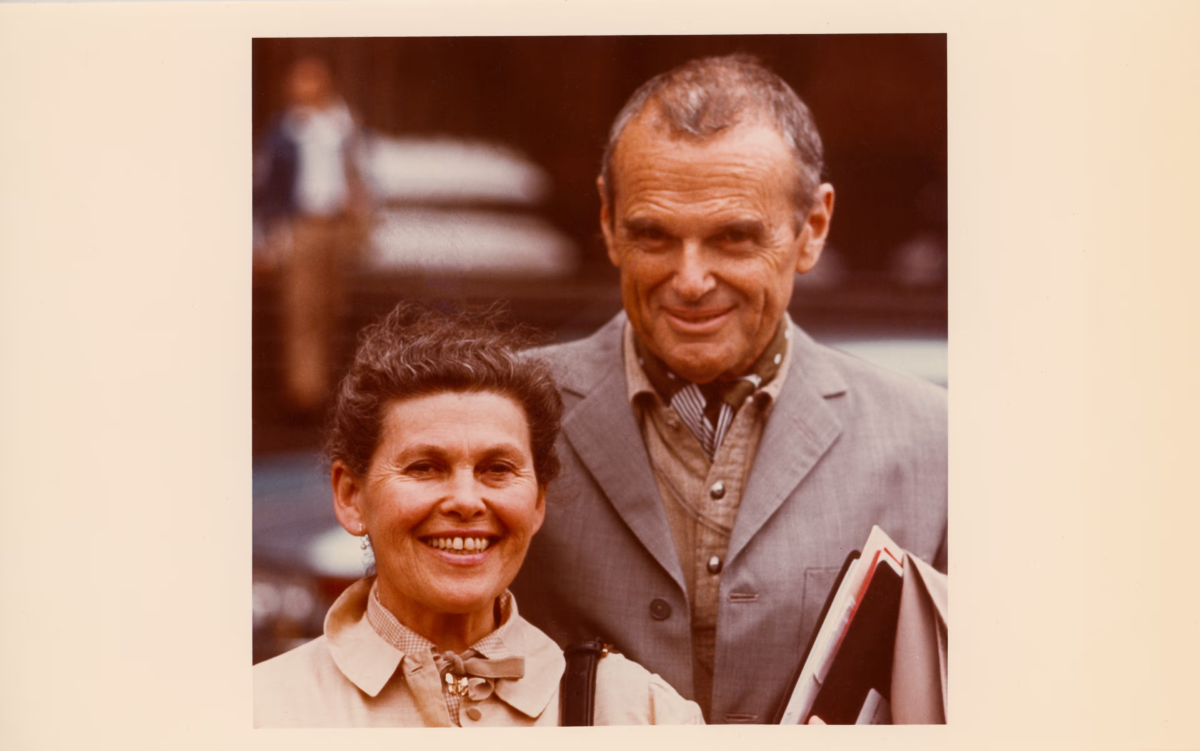For them, furniture should embrace the human body instead of constraining it. Their forms are fluid, rounded, inspired by nature, made possible by technical innovations in molded plywood, fiberglass and injection-molded plastic. This research fits perfectly within the logic of organic design, where industrial technology serves natural forms and universal comfort.
Charles (1907–1978) and Ray (1912–1988) Eames form one of the most emblematic design couples of the 20th century. Based in California, they combined architecture, furniture, photography and cinema in a coherent vision of modern and accessible art of living.
Pioneers of American modernism
Charles and Ray Eames are not simply designers: they embody a total vision of American modernism, a philosophy where beauty, functionality and humanity intertwine. Charles, an architect trained at the Cranbrook school, was driven by technical curiosity and a constructive approach inherited from Bauhaus. Ray, an artist trained in Hans Hofmann’s workshop, brought an acute sense of color, composition and visual poetry.
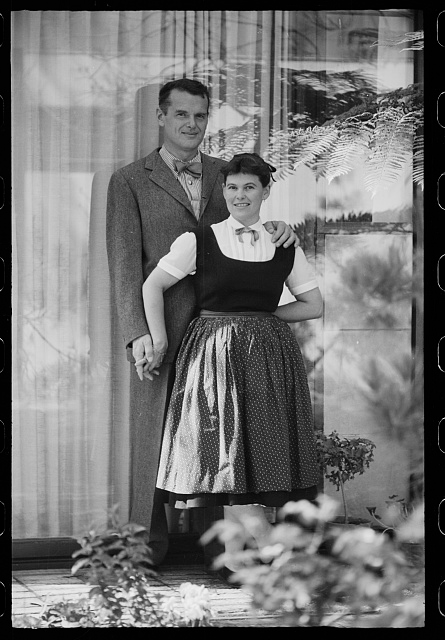
Their meeting in 1940 gave birth to one of the most prolific duos of the 20th century. Together, they dared to marry industrial rigor and artistic sensitivity, exploring new materials like molded plywood, fiberglass or aluminum. Their workshop in Venice, California, was much more than a studio: a laboratory of ideas, where furniture, architecture, films, graphics and exhibitions enriched each other mutually.
The Eames spirit is the search for a rare balance: making everyday life more beautiful, more comfortable, without ever giving up on excellence. From the Eames house, an architectural manifesto open to nature, to their educational films, everything breathes the idea that design is not a discipline reserved for an elite, but a universal language, capable of elevating everyone’s life.
Charles and Ray Eames embody the rare alliance of architectural rigor and artistic sensitivity. He, trained in architecture and passionate about technical innovation; she, from the world of painting and modern art, nourished by a refined visual culture. Their meeting at the Cranbrook design school, in the early 1940s, seals a common destiny: that of reinventing the way we live and use objects.
Their workshop in Venice, California, becomes a true creative laboratory where experimentation never stops. Here, everything is design: furniture, films, exhibitions, architecture. Far from an elitist vision, the Eames place humans at the center. Their philosophy can be summarized in one promise: to offer comfort, beauty and functionality to the greatest number, while elevating daily life through the grace of design.
Eames furniture icons
Their success can also be measured in numbers: the Eames Plastic Chairs, produced from 1950, have been published in several million copies worldwide, becoming an international standard for modern seating. The Lounge Chair & Ottoman, absolute icon launched in 1956, continues to be manufactured in limited series by Herman Miller and Vitra, with several tens of thousands of copies sold since its creation. These impressive volumes illustrate the strength of their vision: a design capable of combining commercial success and cultural value.
LCW – Lounge Chair Wood (1946): the molded plywood revolution
An innovation born from war
In the early 1940s, Charles and Ray Eames experimented with molded plywood to respond to military commissions (medical splints, glider hulls). This research led in 1946 to a radically new piece of furniture: the LCW (Lounge Chair Wood).
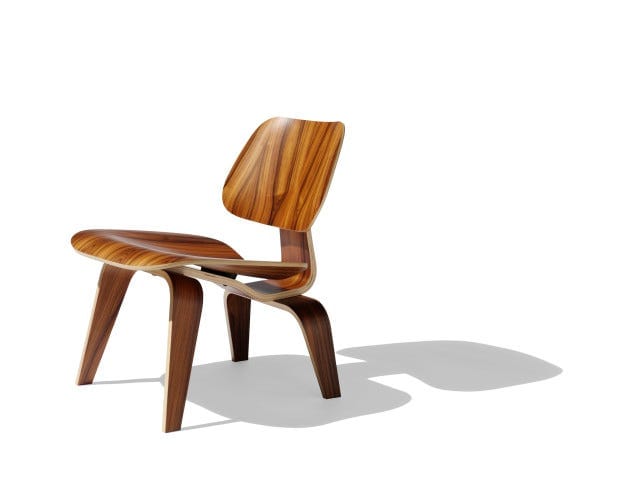
Organic comfort
- Independent seat and backrest fixed by rubber shock mounts, offering flexibility and comfort.
- Entirely wood structure, without metal, which gives an impression of fluid unity.
- Biomorphic forms that embrace the body like never before.
A pioneering piece
Elected by Time magazine “most comfortable chair in the world,” the LCW demonstrates that industry could mass-produce ergonomic and refined furniture. It paves the way for an entire generation of designers who will integrate molded wood into their creations.
Market value and pricing
Vintage examples (1946–50): €2,000 to €5,000 depending on condition and wood species.
Contemporary Vitra / Herman Miller editions: approximately €1,600–2,500.
The Eames Plastic Chairs (1950): democratizing modern design
The first molded plastic chairs
Presented at the MoMA’s Low-Cost Furniture Design competition in 1948, then launched in 1950 with Herman Miller, the Plastic Chairs are the first chairs produced in molded plastic (originally fiberglass, then recycled polypropylene today).
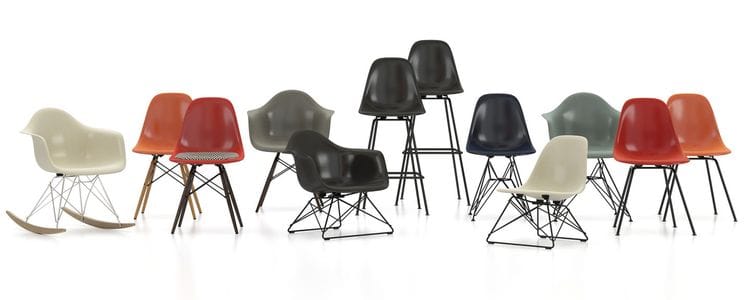
Modularity and diversity
- A single shell seat declined in multiple versions (wood legs, metal, rocking chair, stackable…).
- Wide palette of bright colors that make them icons of 1950s optimism.
- Designed for daily life, from office to kitchen.
Global success
The Plastic Chairs sold several million copies worldwide. They represent the Eames promise: beautiful and practical for everyone. They still appear today in the collections of the Vitra Design Museum, MoMA or the greatest contemporary interiors.
Market value and pricing
Restoration: cleaning, polishing or fiberglass repair €200–400.
Vintage (1950s–60s, original fiberglass): €800 to €2,000 depending on rarity and color.
Vitra reissues: €350–500 new.
Eames Lounge Chair & Ottoman (1956)
Absolute masterpiece, this armchair in rosewood and leather has lost none of its aura. Both a symbol of modern luxury and technical prowess, it marries domestic comfort and nobility of materials, becoming a must-have for the American cultural elite of the 1950s. Eames Lounge Chair & Ottoman (1956): accessible modern luxury
A creation conceived as heritage
Designed in 1956, the Lounge Chair was born from Charles Eames’ desire to offer his filmmaker friend Billy Wilder a reading chair “as comfortable as a worn baseball glove.” The idea was to associate the artisanal warmth of curved wood with the industrial precision of Herman Miller techniques.
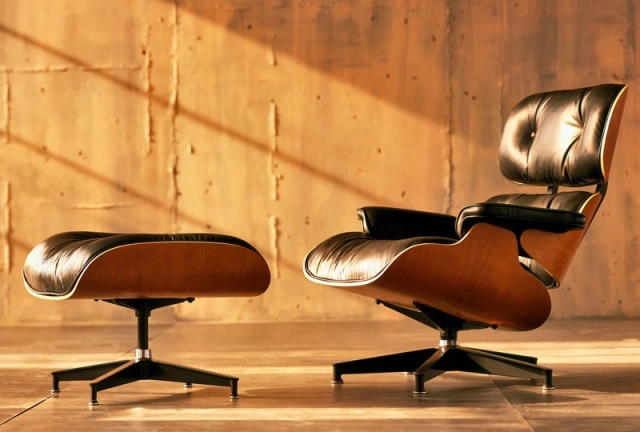
Noble materials, avant-garde technicality
Each armchair requires meticulous manufacturing, where craftsmanship and industry complement each other.
- Molded plywood shells, originally veneered with Rio rosewood (since replaced by sustainable species).
- Leather-padded cushions with feathers and foam, detachable and interchangeable.
- Five-branch polished aluminum base, providing lightness and stability.
- Modular design allowing maintenance and replacement of worn parts – a rarity at the time.
An aesthetic and cultural breakthrough
Unlike traditional armchairs of the era, heavy and imposing, the Lounge Chair combines elegance and relaxation. It introduces a new idea of luxury:
- less ostentatious,
- more ergonomic,
- designed for daily comfort.
Very quickly, it becomes a status symbol of American modernity, adopted by architects, intellectuals and collectors worldwide.
Distribution and legacy of the Ottoman chair
- Published since 1956 by Herman Miller in the United States, and by Vitra in Europe since 1957.
- Still in production today, it embodies the longevity of great classics.
- Available in multiple variants (walnut, cherry, black-stained ash, white, tobacco or black leather).
Lounge chair: Market value and pricing
- Vintage examples (1950s–60s): €6,000 to €12,000 depending on condition, leather and veneer.
- New Vitra / Herman Miller reissues: €8,000 to €12,000 depending on finishes.
- Restorations: leather reupholstering between €1,500 and €2,500, wood polishing €500–1,000.
A living myth
The Lounge Chair is more than an armchair: it is a statement of intent. It embodies the Eames’ ability to marry comfort, technical innovation and timeless aesthetics. Still present in films, museums, collectors’ homes, it remains one of the most brilliant symbols of what design can be: a discreet, functional and profoundly human luxury.
The Eames House (Case Study House #8, 1949)
Much more than a residence, the house that Charles and Ray built in Pacific Palisades is an architectural manifesto. Metal structure, colored panels, opening to the landscape: the Eames House reflects a modern and optimistic art of living, where architecture and nature dialogue in harmony. In 1949, as part of the Californian Case Study Houses program launched by Arts & Architecture magazine, Charles and Ray Eames design their own residence on a sloping site overlooking the Pacific Ocean, in Pacific Palisades, Los Angeles.
The program’s commission was clear: invent a model of modern house, reproducible, accessible, responding to postwar lifestyles. The Eames, they will go beyond the simple architectural exercise to create a living space that embodies their total vision of design.
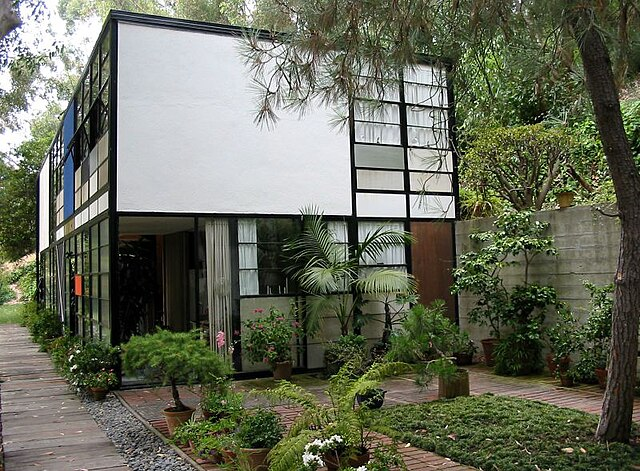
An architecture of light and color
- Standard steel metal structure, reminiscent of industrial hangars.
- Glass modules and painted panels, forming a rhythmic facade like an abstract composition by Mondrian.
- Interior bathed in light, conceived as an inhabited workshop: work and living space cohabit without hierarchy.
- Perfect integration into the surrounding nature: the house embraces the slope, open to eucalyptus and garden.
A house-laboratory
The Eames House is not just a dwelling place: it’s a creation laboratory. One finds there:
- their furniture prototypes,
- objects collected from around the world (masks, textiles, ceramics),
- an abundant visual and intellectual library.
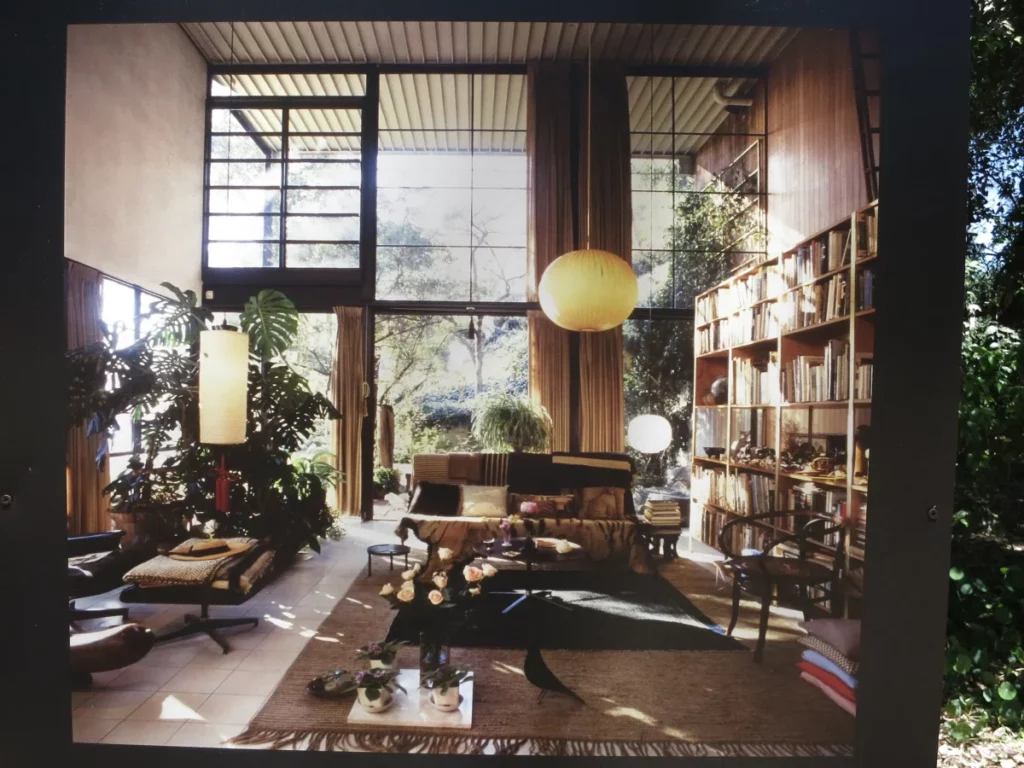
It’s there that they shot some of their films, received architects, artists and industrialists, and imagined future icons of world design.
An embodied philosophy
The house illustrates their credo:
- Design as art of living, not just as object.
- Openness to the world: each room testifies to humanistic curiosity.
- Constructive simplicity, allied with the warmth of materials and colors.
Heritage and recognition
Classified as a national historic monument in 2006, the house is today preserved by the Eames Foundation. It can be visited by appointment and remains a pilgrimage site for designers, architects and modernism enthusiasts.
It is both intimate house and universal manifesto, symbol of a design that refuses ostentation to prefer intelligence of forms and harmony with nature.
Collaborations and emblematic partners
Throughout their career, Charles and Ray Eames knew how to surround themselves with publishers, institutions and creators capable of carrying their ideas to the highest level.
Publishers and institutions
- Herman Miller: historic partner from 1946, publisher of the LCW, Plastic Chairs, Lounge Chair and Aluminium Group series.
- Vitra: European partner since 1957, guarantor of faithful production and international distribution.
- MoMA – Museum of Modern Art: pioneering exhibitions and founding competitions like the 1948 Low-Cost Furniture Design.
- IBM: collaborations in the 1960s for educational films and multimedia exhibitions, notably at the 1964 World’s Fair.
- US Information Agency – Expo 58 Brussels: design of the American pavilion during the 1958 World’s Fair, showcase of American modernism.
Designers and creators
- Eero Saarinen: co-author of the Organic Chair (1940) with Charles Eames, friend and companion of experiments at Cranbrook.
- George Nelson: artistic director of Herman Miller, in constant dialogue with the Eames on the evolution of modern furniture.
- Alexander Girard: textile designer, responsible for fabrics and patterns that dressed Eames furniture, indispensable aesthetic ally.
- Isamu Noguchi: sculptor and designer, close to the couple, sharing an organic sensibility and exhibition projects.
- Harry Bertoia: Cranbrook classmate, known for his wire chairs, with whom the Eames shared research and workshops.
These collaborations allowed the Eames to go beyond the simple status of furniture designers to become true ambassadors of modernism, connecting industry, art, education and cultural diplomacy.
An innovative vision of design
The Eames did not conceive design as an isolated discipline, but as a global language. From their chairs to their educational films (Powers of Ten), everything translates the same spirit of experimentation and transmission. Their collaboration with Herman Miller, then with Vitra in Europe, ensured their creations global distribution, while guaranteeing an exceptional standard of quality.
They were also educators, convinced that visual culture could transform society. Their work goes beyond the object to become a true philosophy of life: joyful, accessible, demanding.
Heritage and posterity
Today still, the Eames remain an unmissable reference. Their creations are exhibited at New York’s MoMA, the Vitra Design Museum or in the greatest private collections. Their aesthetic crosses time without aging, because it rests on universal values: simplicity, comfort, intelligence of forms.
The Eames heritage also resides in this capacity to make industry and poetry dialogue, to remind that design, far from being a superficial luxury, can transform our relationship to the world.
Advice for collectors and enthusiasts
- Always verify authenticity: Herman Miller or Vitra labels, serial number, provenance.
- Examine the natural patina of wood and quality of finishes.
- Inform yourself about restoration costs before purchase, to avoid bad surprises.
- Favor specialized galleries, auctions or recognized platforms to guarantee lasting value.
Resources
Design Fundamentals
History of Design & Decorative Styles
From baroque salons to the radical lines of the 20th century, this chronological timeline highlights the aesthetic revolutions that have marked our daily environment.
Read the page “History of Design & Decorative Styles”Hart Design Glossary from A to Z
Sabre legs, patina, passementerie, caning… This lexicon gives meaning to the technical and stylistic terms often used in the design world.
Access the Hart Design GlossaryHart Glossary of Design Icons
This glossary lists all the great names in design and decoration in alphabetical order. Discover the creators who have shaped contemporary living art.
Access the Hart Glossary of Design Icons
Digital entrepreneur and craft artisan, I use my unconventional background to share my vision of luxury design and interior decoration — one enriched by craftsmanship, history, and contemporary creation. Since 2012, I have been working daily in my workshop on the shores of Lake Annecy, creating bespoke interiors for discerning decorators and private clients.

